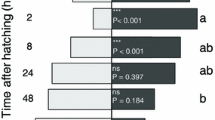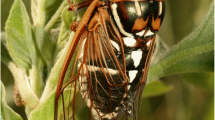Abstract
Until recently, studies on host-parasitoid interactions have rarely reported the detection and resistance of parasitoids by hosts prior to experiencing a direct attack. Several recent studies have indicated that some hosts have an ability to detect parasitoids without being attacked directly. However, the particular cues used for parasitoid detection have received little attention. We investigate the use of airborne cues (such as volatile chemicals or sound) by the water strider Aquarius paludum insularis (Heteroptera: Gerridae) for detecting its egg parasitoid wasp. Since A. paludum females with previous exposure to the parasitoids oviposit at deeper positions relative to unexposed females, we were able to infer whether A. paludum had detected the parasitoid from oviposition depth. We allowed A. paludum to oviposit after one of the three treatments: exposure to the parasitoid directly, airborne cues (the parasitoid was enclosed in the tube of which ends were sealed by mesh), or wasp absent. The oviposition depth was shallower in A. paludum with exposure to airborne cues than in A. paludum with exposure to the parasitoids directly. The depth did not differ between airborne cues and wasp absent treatments. These results indicate that A. paludum were not able to detect the parasitoid from airborne cues alone.


Similar content being viewed by others

References
Amano, H., K. Hayashi & E. Kasuya, 2008. Avoidance of egg parasitism through submerged oviposition by tandem pairs in the water strider, Aquarius paludum insularis (Heteroptera: Gerridae). Ecological Entomology 33(4): 560–563.
Carrasco, D. & A. Kaitala, 2009. Egg-laying tactic in Phyllomorpha laciniata in the presence of parasitoids. Entomologia Experimentalis Et Applicata 131(3): 300–307.
Corbet, P. S., 1999. Dragonflies: Behaviour and Ecology of Odonata. Harley Books, Essex.
Crowl, T. A. & A. P. Covich, 1994. Responses of a freshwater shrimp to chemical and tactile stimuli from a large decapod predator. Journal of the North American Benthological Society. 13: 291–298.
Deas, J. B. & M. S. Hunter, 2012. Mothers modify eggs into shields to protect offspring from parasitism. Proceedings of the Royal Society B: Biological Sciences 279(1730): 847–853.
Deas, J. B. & M. S. Hunter, 2013. Delay, avoidance and protection in oviposition behaviour in response to fine-scale variation in egg parasitism risk. Animal Behaviour 86(5): 933–940.
Ferrari, M. C. O., B. D. Wisenden & D. P. Chivers, 2010. Chemical ecology of predator-prey interactions in aquatic ecosystems: a review and prospectus the present review is one in the special series of reviews on animal-plant interactions. Canadian Journal of Zoology 88(7): 698–724.
Godfray, H. & J. Charles, 1994. Parasitoids: behavioral and evolutionary ecology. Princeton University Press, Princeton.
Gross, P., 1993. Insect behavioral and morphological defenses against parasitoids. Annual Review of Entomology 38(1): 251–273.
Henriquez, N. P. & J. R. Spence, 1993. Studies of lathromeroidea sp. nov (hymenoptera: Trichogrammatidae), a parasitoid of gerrid eggs. The Canadian Entomologist 125(04): 693–702.
Hirayama, H., & E. Kasuya, 2014. Potential costs of selecting good sites for offspring: increased risk of drowning and negative effects on egg production. Ethology 120(12): 1228–1236. doi:10.1111/eth.12296.
Hirayama, H. & E. Kasuya, 2010. Cost of oviposition site selection in a water strider Aquarius paludum insularis: egg mortality increases with oviposition depth. Journal of Insect Physiology 56(6): 646–649.
Hirayama, H. & E. Kasuya, 2008. Factors affecting submerged oviposition in a water strider: level of dissolved oxygen and male presence. Animal Behaviour 76(6): 1919–1926.
Hirayama, H. & E. Kasuya, 2009. Oviposition depth in response to egg parasitism in the water strider: high-risk experience promotes deeper oviposition. Animal Behaviour 78(4): 935–941.
Hoffmeister, T. S. & B. D. Roitberg, 1997. Counterespionage in an insect herbivore-parasitoid system. Naturwissenschaften 84(3): 117–119.
Holm, S., 1979. A simple sequentially rejective multiple test procedure. Scandinavian Journal of Statistics 6: 65–70.
Kacsoh, B. Z., Z. R. Lynch, Nathan. T. Mortimer & T. A. Schlenke, 2013. Fruit flies medicate offspring after seeing parasites. Science 339(6122): 947–950.
Kats, L. B. & L. M. Dill, 1998. The scent of death: chemosensory assessment of predation risk by prey animals. Ecoscience 5(3): 361–394.
Kohmura, H. & H. Hirayama & U. Takatoshi, in press. Diving into the water: cues related to the decision-making by an egg parasitoid attacking underwater hosts. Ethology. doi: 10.1111/eth.12326.
Lima, S. L., 1998. Stress and decision making under the risk of predation: recent developments from behavioral, reproductive, and ecological perspectives. Advances in the Study of Behavior 27: 215–290.
Ode, P. R. & S. A. Wissinger, 1993. Interaction between chemical and tactile cues in mayfly detection of stoneflies. Freshwater Biology 30(3): 351–357.
Pathak, J. P. N., 1993. Insect Immunity, Vol. 48. Springer, Berlin.
R Core Team (2013). R: a language and environment for statistical computing. R Foundation for Statistical Computing, Vienna, Austria [available on internet at http://www.R-project.org/].
Stauffer, H.-P. & R. D. Semlitsch, 1993. Effects of visual, chemical and tactile cues of fish on the behavioural responses of tadpoles. Animal Behaviour 46(2): 355–364.
Vinson, S. B., 1990. How parasitoids deal with the immune system of their host: an overview. Archives of Insect Biochemistry and Physiology 13(1–2): 3–27.
Acknowledgements
We wish to express our gratitude to all our colleagues at the Laboratory of Ecological Science, Kyushu University, for their help and encouragement. Particularly, we would like to express our gratitude to Maasa Nobayashi for her invaluable contribution. We also thank Chris Wood for editing the manuscript. This work was supported in part by JSPS KAKENHI Grant numbers 22370010 and 25650149, and by the Environment Research and Technology Development Fund (S9) of the Ministry of the Environment, Japan.
Author information
Authors and Affiliations
Corresponding author
Additional information
Handling editor: Lee B. Kats
Electronic supplementary material
Below is the link to the electronic supplementary material.
Rights and permissions
About this article
Cite this article
Hirayama, H., Kasuya, E. Parasitoid avoidance behavior is not triggered by airborne cues in a semi-aquatic bug. Hydrobiologia 745, 195–200 (2015). https://doi.org/10.1007/s10750-014-2107-y
Received:
Revised:
Accepted:
Published:
Issue Date:
DOI: https://doi.org/10.1007/s10750-014-2107-y



